Electric Field-Assisted Filling of Sulfonated Polymers in ePTFE Backing Material for Fuel Cell
Abstract
1. Introduction
2. Materials and Methods
2.1. SA8 Procedure for Sulfonation
2.2. Preparation of Polymer Membrane
2.3. Observation under SEM
2.4. X-ray Diffractometer
2.5. IEC Measurement
2.6. Water Uptake and Dimensional Stability
2.7. Swelling Ratio Test
2.8. Hydration Number (λ)
2.9. Proton Conductivity Measurement
2.10. Membrane Electrode Preparation and Single Cell Efficiency Measurement
3. Results
3.1. SEM Microstructure Analysis
3.2. XRD Diffraction Diagram Analysis
3.3. IEC Value of Composite Membrane
3.4. Water Uptake and λ Value of Membrane
3.5. Dimensional Stability of Membrane
3.6. Swelling Ratio of Membrane
3.7. Proton Conductivity Data Analysis for Composite Membranes
3.8. Fuel Cell Component Efficiency Analysis
4. Conclusions
5. Patents
Author Contributions
Funding
Institutional Review Board Statement
Informed Consent Statement
Data Availability Statement
Acknowledgments
Conflicts of Interest
References
- Sun, C.; Negro, E.; Vezzù, K.; Pagot, G.; Cavinato, G.; Nale, A.; Bang, Y.H.; Di Noto, V. Hybrid inorganic-organic proton-conducting membranes based on SPEEK doped with WO3 nanoparticles for application in vanadium redox flow batteries. Electrochim. Acta 2019, 309, 311–325. [Google Scholar] [CrossRef]
- Okonkwo, P.C.; Belgacem, I.B.; Emori, W.; Uzoma, P.C. Nafion degradation mechanisms in proton exchange membrane fuel cell (PEMFC) system: A review. Int. J. Hydrogen Energy 2021, 46, 27956–27973. [Google Scholar] [CrossRef]
- Yang, D.; Tan, Y.; Li, B.; Ming, P.; Xiao, Q.; Zhang, C. A Review of the Transition Region of Membrane Electrode Assembly of Proton Exchange Membrane Fuel Cells: Design, Degradation, and Mitigation. Membranes 2022, 12, 306. [Google Scholar] [CrossRef] [PubMed]
- Xing, L.; Xiang, W.; Zhu, R.; Tu, Z. Modeling and thermal management of proton exchange membrane fuel cell for fuel cell/battery hybrid automotive vehicle. Int. J. Hydrogen Energy 2022, 47, 1888–1900. [Google Scholar] [CrossRef]
- Selim, A.; Szijjártó, G.P.; Tompos, A. Insights into the Influence of Different Pre-Treatments on Physicochemical Properties of Nafion XL Membrane and Fuel Cell Performance. Polymers 2022, 14, 3385. [Google Scholar] [CrossRef]
- Chen, Y.; Liu, Y.; Xu, Y.; Guo, X.; Cao, Y.; Ming, W. Modeling and Simulation of Membrane Electrode Material Structure for Proton Exchange Membrane Fuel Cells. Coatings 2022, 12, 1145. [Google Scholar] [CrossRef]
- Sun, C.Y.; Zhang, H. Investigation of Nafion series membranes on the performance of iron-chromium redox flow battery. Int. J. Energy Res. 2019, 43, 8739–8752. [Google Scholar] [CrossRef]
- Yin, C.; Li, J.; Zhou, Y.; Zhang, H.; Fang, P.; He, C. Phase separation and development of proton transport pathways in metal oxide nanoparticle/nafion composite membranes during water uptake. J. Phys. Chem. C 2018, 122, 9710–9717. [Google Scholar] [CrossRef]
- Kwon, O.; Park, J. Analysis of Ionic Domain Evolution on a Nafion-Sulfonated Silica Composite Membrane Using a Numerical Approximation Model Based on Electrostatic Force Microscopy. Polymers 2022, 14, 3718. [Google Scholar] [CrossRef]
- Maiti, T.K.; Singh, J.; Dixit, P.; Majhi, J.; Bhushan, S.; Bandyopadhyay, A.; Chattopadhyay, S. Advances in perfluorosulfonic acid-based proton exchange membranes for fuel cell applications: A review. Chem. Eng. J. Adv. 2022, 12, 100372. [Google Scholar] [CrossRef]
- Hickner, M.A.; Ghassemi, H.; Kim, Y.S.; Einsla, B.R.; McGrath, J.E. Alternative polymer systems for proton exchange membranes (PEMs). Chem. Rev. 2004, 104, 4587–4612. [Google Scholar] [CrossRef] [PubMed]
- Mauritz, K.A.; Moore, R.B. State of understanding of Nafion. Chem. Rev. 2004, 104, 4535–4586. [Google Scholar] [CrossRef] [PubMed]
- Li, J.; Xu, G.; Luo, X.; Xiong, J.; Liu, Z.; Cai, W. Effect of nano-size of functionalized silica on overall performance of swelling-filling modified Nafion membrane for direct methanol fuel cell application. Appl. Energy 2018, 213, 408–414. [Google Scholar] [CrossRef]
- Steffy, N.; Parthiban, V.; Sahu, A. Uncovering Nafion-multiwalled carbon nanotube hybrid membrane for prospective polymer electrolyte membrane fuel cell under low humidity. J. Membr. Sci. 2018, 563, 65–74. [Google Scholar] [CrossRef]
- Xia, Z.; Wang, S.; Jiang, L.; Sun, H.; Qi, F.; Jin, J.; Sun, G. Rational design of a highly efficient Pt/graphene–Nafion® composite fuel cell electrode architecture. J. Mater. Chem. A 2015, 3, 1641–1648. [Google Scholar] [CrossRef]
- Branchi, M.; Sgambetterra, M.; Pettiti, I.; Panero, S.; Navarra, M.A. Functionalized Al2O3 particles as additives in proton-conducting polymer electrolyte membranes for fuel cell applications. Int. J. Hydrogen Energy 2015, 40, 14757–14767. [Google Scholar] [CrossRef]
- Tang, H.; Pan, M.; Wang, X.; Ruan, Y. Fabrication and characterization of PFSI/ePTFE composite proton exchange membranes of polymer electrolyte fuel cells. Electrochim. Acta 2007, 52, 5304–5311. [Google Scholar] [CrossRef]
- Lin, H.-L.; Yu, T.L.; Han, F.-H. A method for improving ionic conductivity of Nafion membranes and its application to PEMFC. J. Polym. Res. 2006, 13, 379–385. [Google Scholar] [CrossRef]
- Lee, J.-Y.; Lee, J.-H.; Ryu, S.; Yun, S.-H.; Moon, S.-H. Electrically aligned ion channels in cation exchange membranes and their polarized conductivity. J. Membr. Sci. 2015, 478, 19–24. [Google Scholar] [CrossRef]
- Kim, J.-H.; Ryu, S.; Lee, J.-Y.; Moon, S.-H. Preparation of high-conductivity QPPO (quaternary-aminated poly (2, 6-dimethyl-1, 4-phenyleneoxide)) membranes by electrical treatment. J. Membr. Sci. 2018, 553, 82–89. [Google Scholar] [CrossRef]
- Ryu, S.; Kim, J.-H.; Lee, J.-Y.; Moon, S.-H. Investigation of the effects of electric fields on the nanostructure of Nafion and its proton conductivity. J. Mater. Chem. A 2018, 6, 20836–20843. [Google Scholar] [CrossRef]
- Huang, W.; Liaw, B.; Chang, M.; Han, Y.; Huang, P. High glass-transition temperature and organosoluble novel arylene ether polymers. Macromolecules 2007, 40, 8649–8657. [Google Scholar] [CrossRef]
- Huang, W.Y.; Chang, M.; Han, Y.; Huang, P. Sterically encumbered poly (arylene ether) s containing spiro-annulated substituents: Synthesis and thermal properties. J. Polym. Sci. Part A Polym. Chem. 2010, 48, 5872–5884. [Google Scholar] [CrossRef]
- Lee, C.-C.; Huang, W.-Y. The influence of arylene ether positions and phenyl substituents on the physical properties of functional fluorinated polymers. Polym. J. 2011, 43, 180–185. [Google Scholar] [CrossRef][Green Version]
- Ryu, S.; Lee, B.; Kim, J.H.; Pak, C.; Moon, S.H. High-temperature operation of PEMFC using pore-filling PTFE/Nafion composite membrane treated with electric field. Int. J. Energy Res. 2021, 45, 19136–19146. [Google Scholar] [CrossRef]
- Huang, T.-S.; Hsieh, T.-L.; Lai, C.-C.; Wen, H.-Y.; Huang, W.-Y.; Chang, M.-Y. Highly Proton-Conducting Membranes Based on Poly(arylene ether)s with Densely Sulfonated and Partially Fluorinated Multiphenyl for Fuel Cell Applications. Membranes 2021, 11, 626. [Google Scholar] [CrossRef] [PubMed]
- Figoli, A.; Marino, T.; Galiano, F. Polymeric membranes in biorefinery. Membr. Technol. Biorefin. 2016, 29–59. [Google Scholar] [CrossRef]
- Moukheiber, E.; De Moor, G.; Flandin, L.; Bas, C. Investigation of ionomer structure through its dependence on ion exchange capacity (IEC). J. Membr. Sci. 2012, 389, 294–304. [Google Scholar] [CrossRef]
- Ye, Y.-S.; Yen, Y.-C.; Cheng, C.-C.; Chen, W.-Y.; Tsai, L.-T.; Chang, F.-C. Sulfonated poly (ether ether ketone) membranes crosslinked with sulfonic acid containing benzoxazine monomer as proton exchange membranes. Polymer 2009, 50, 3196–3203. [Google Scholar] [CrossRef]
- Chen, R.; Xu, F.; Fu, K.; Zhou, J.; Shi, Q.; Xue, C.; Lyu, Y.; Guo, B.; Li, G. Enhanced proton conductivity and dimensional stability of proton exchange membrane based on sulfonated poly (arylene ether sulfone) and graphene oxide. Mater. Res. Bull. 2018, 103, 142–149. [Google Scholar] [CrossRef]
- Springer, T.E.; Zawodzinski, T.; Gottesfeld, S. Polymer electrolyte fuel cell model. J. Electrochem. Soc. 1991, 138, 2334. [Google Scholar] [CrossRef]
- da Silva, J.S.; Carvalho, S.G.; da Silva, R.P.; Tavares, A.C.; Schade, U.; Puskar, L.; Fonseca, F.C.; Matos, B.R. SAXS signature of the lamellar ordering of ionic domains of perfluorinated sulfonic-acid ionomers by electric and magnetic field-assisted casting. Phys. Chem. Chem. Phys. 2020, 22, 13764–13779. [Google Scholar]

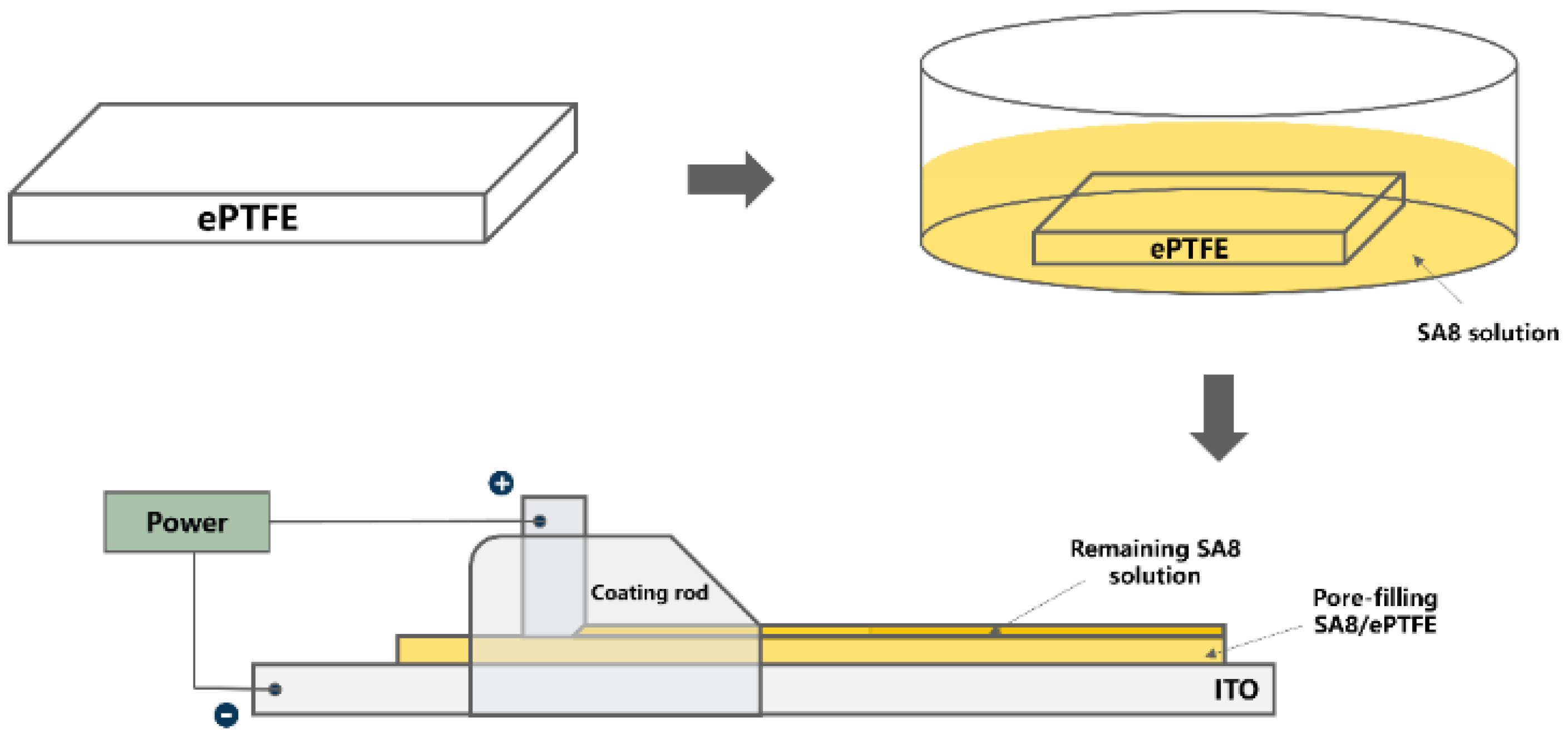
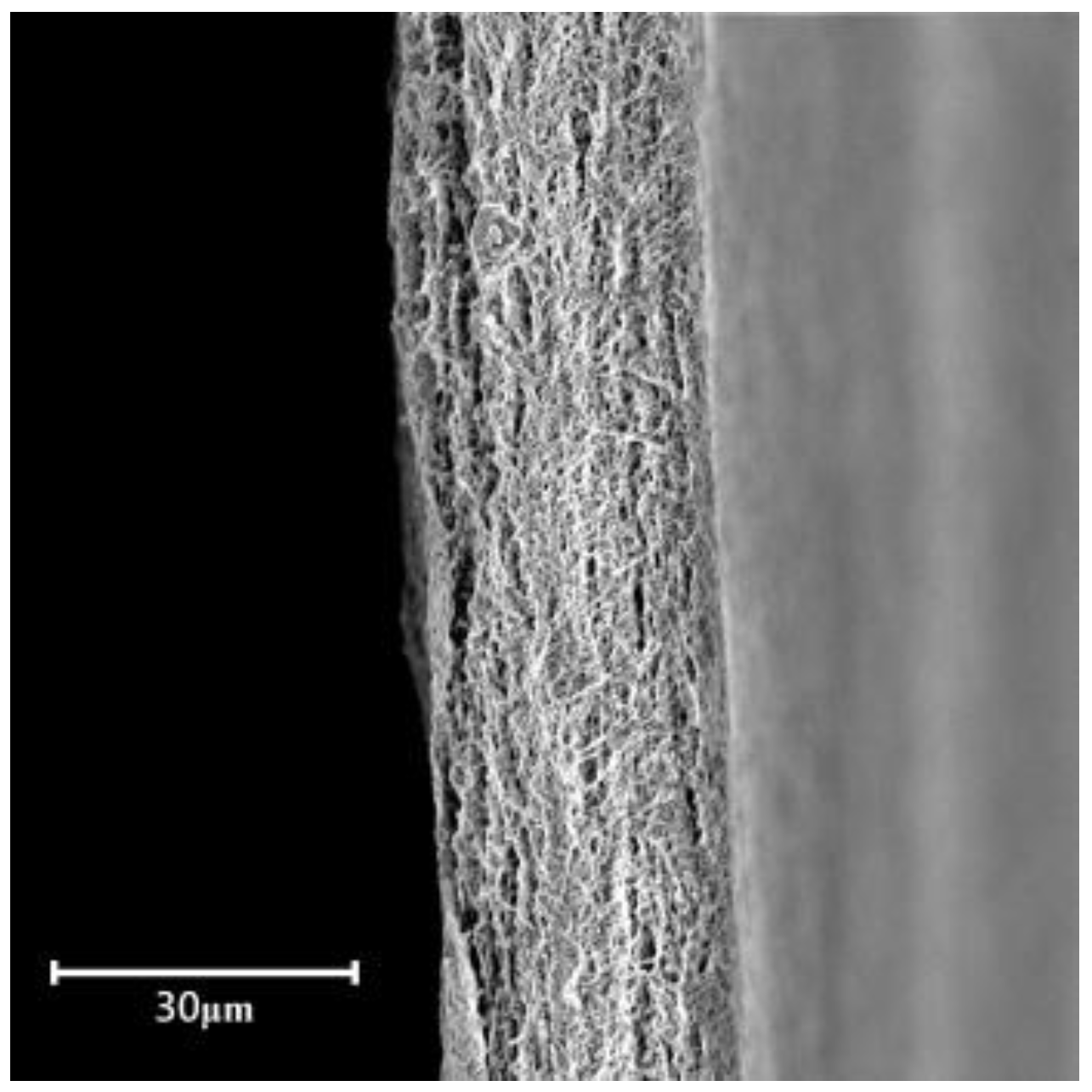
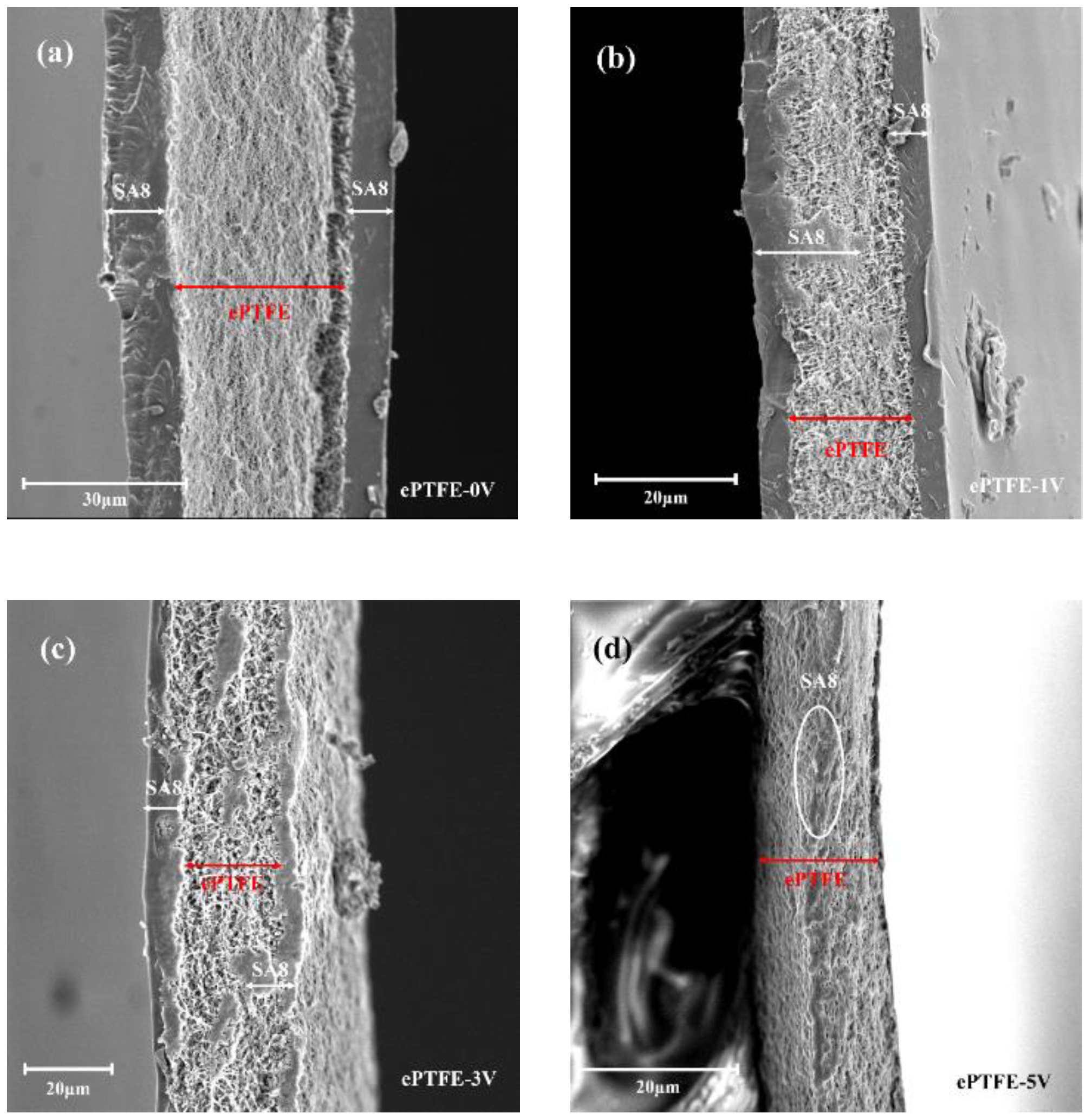

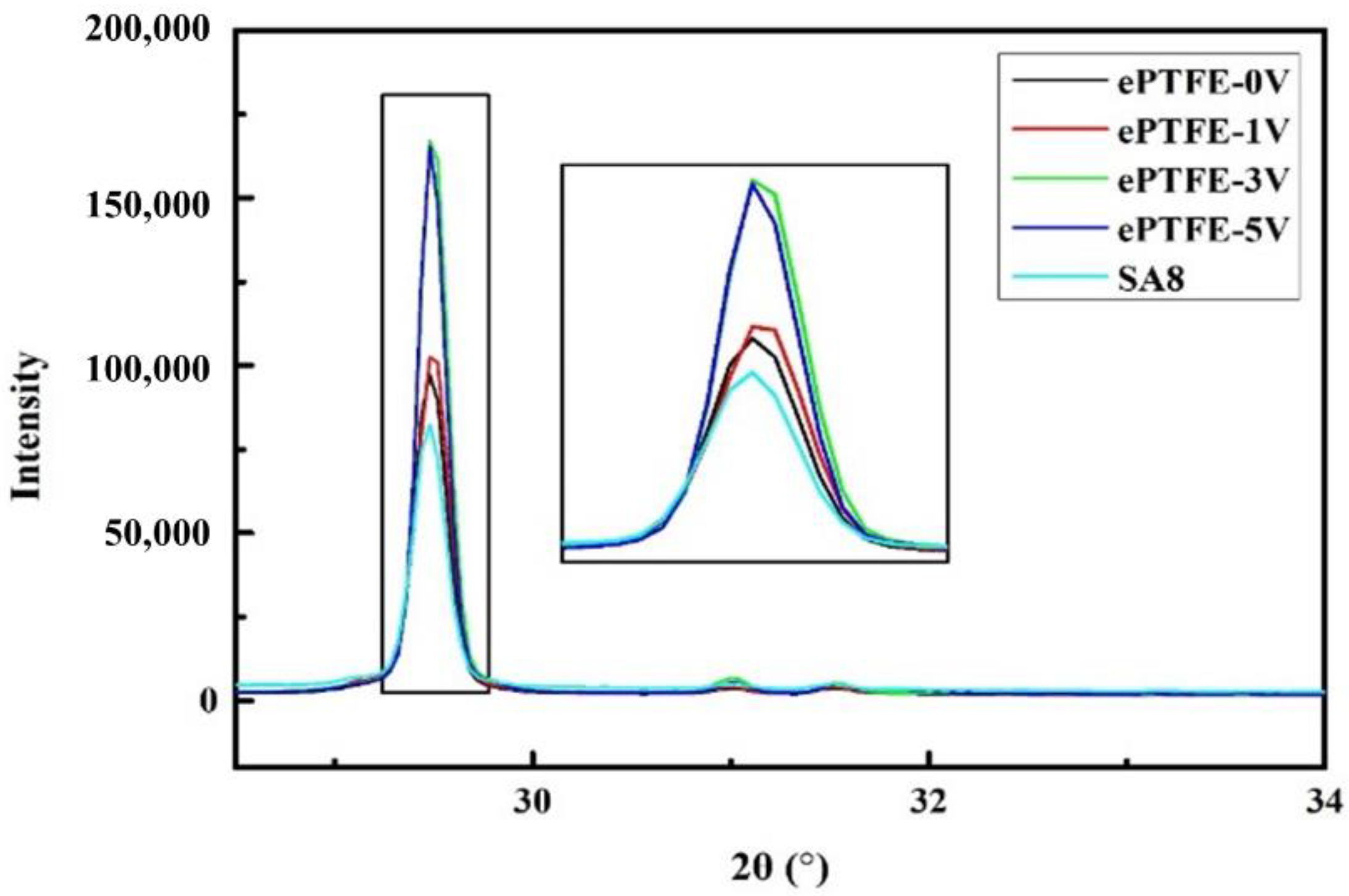
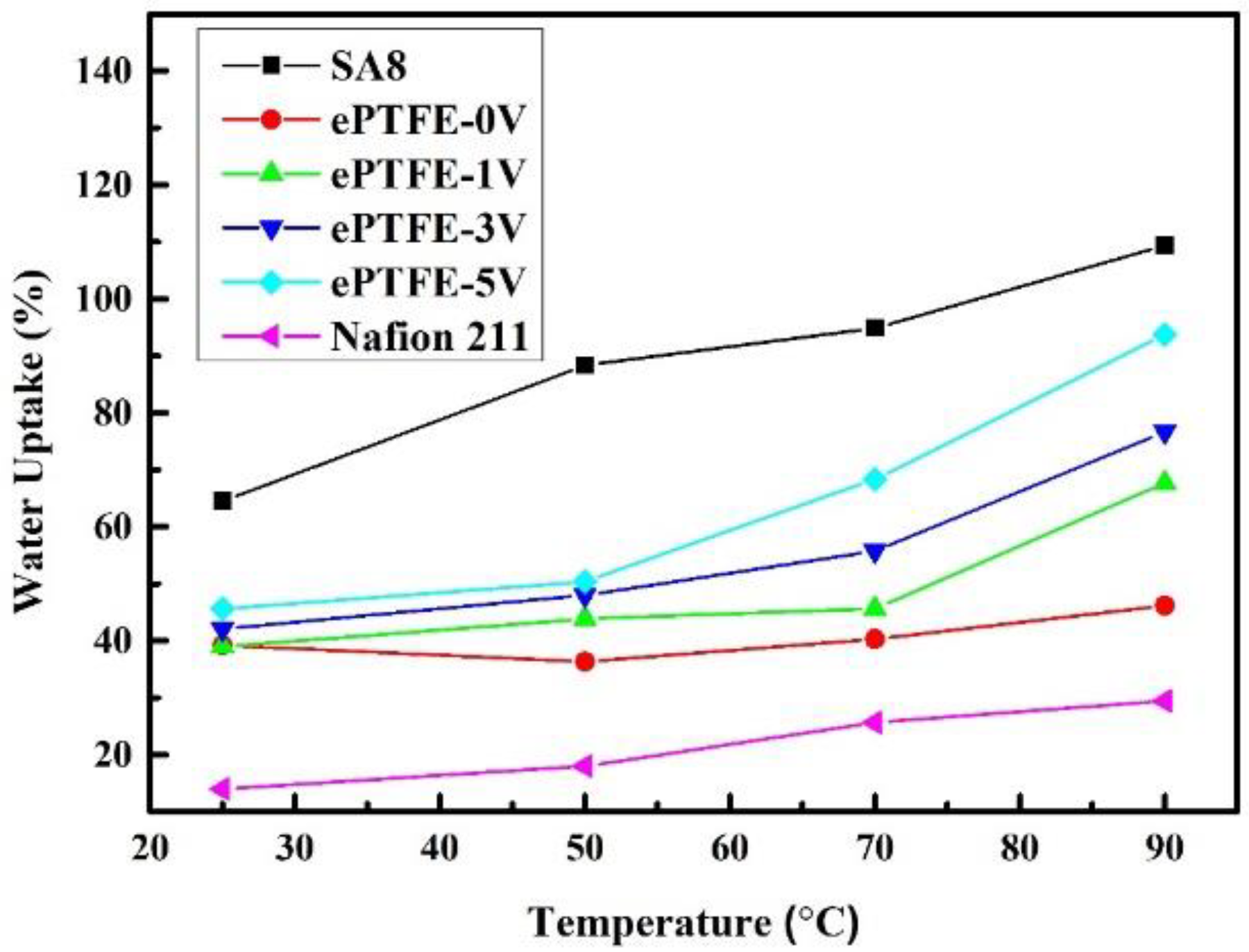
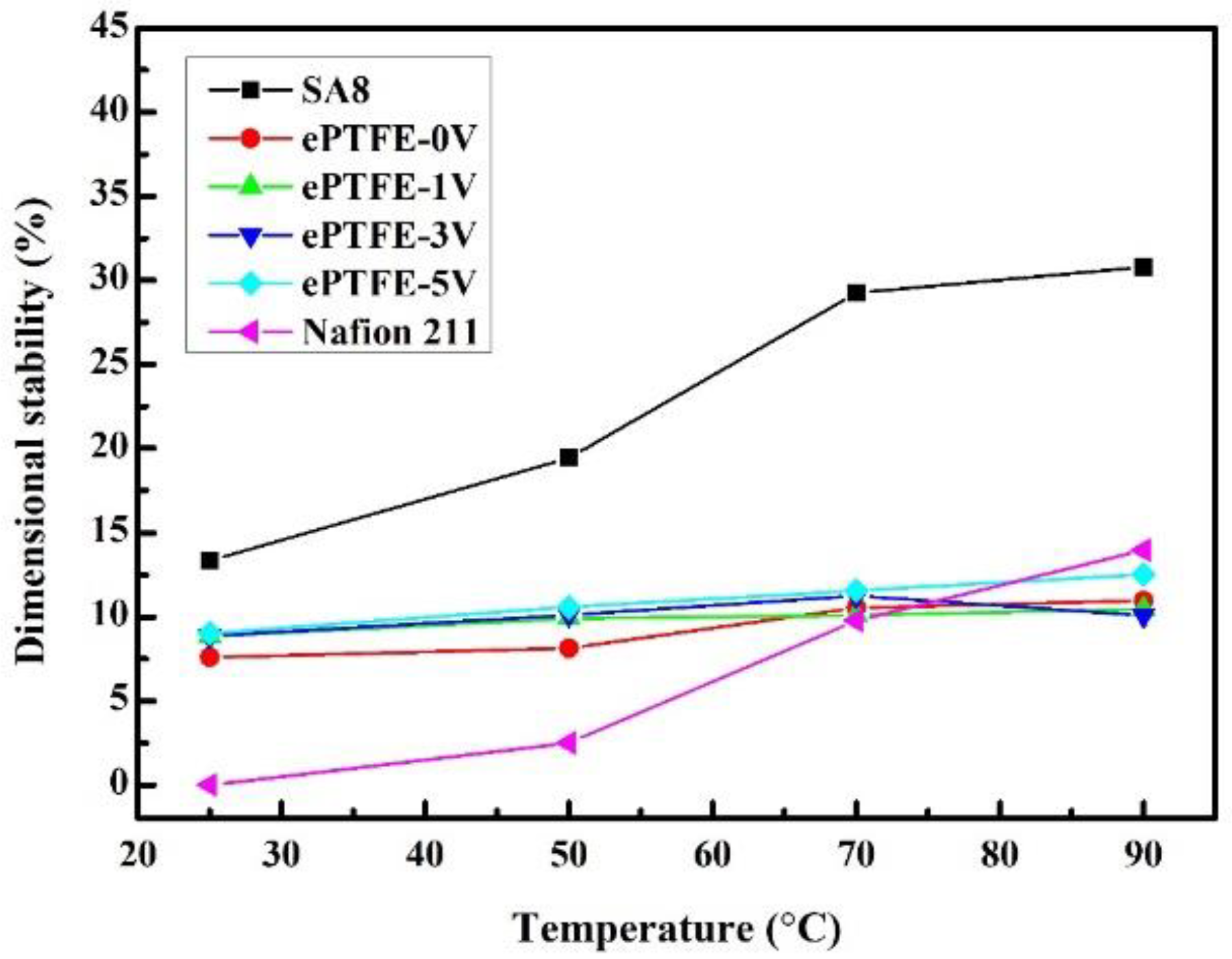
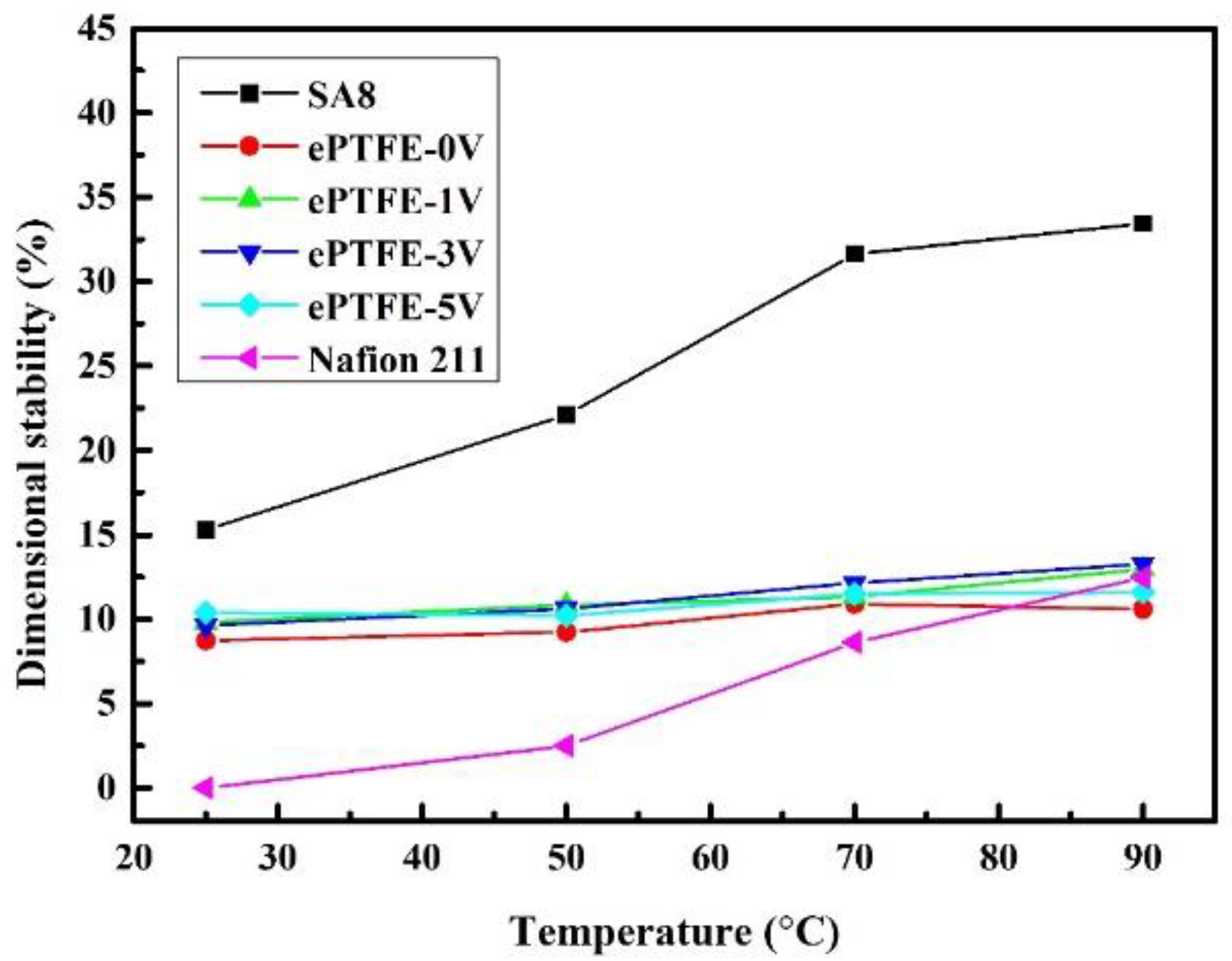

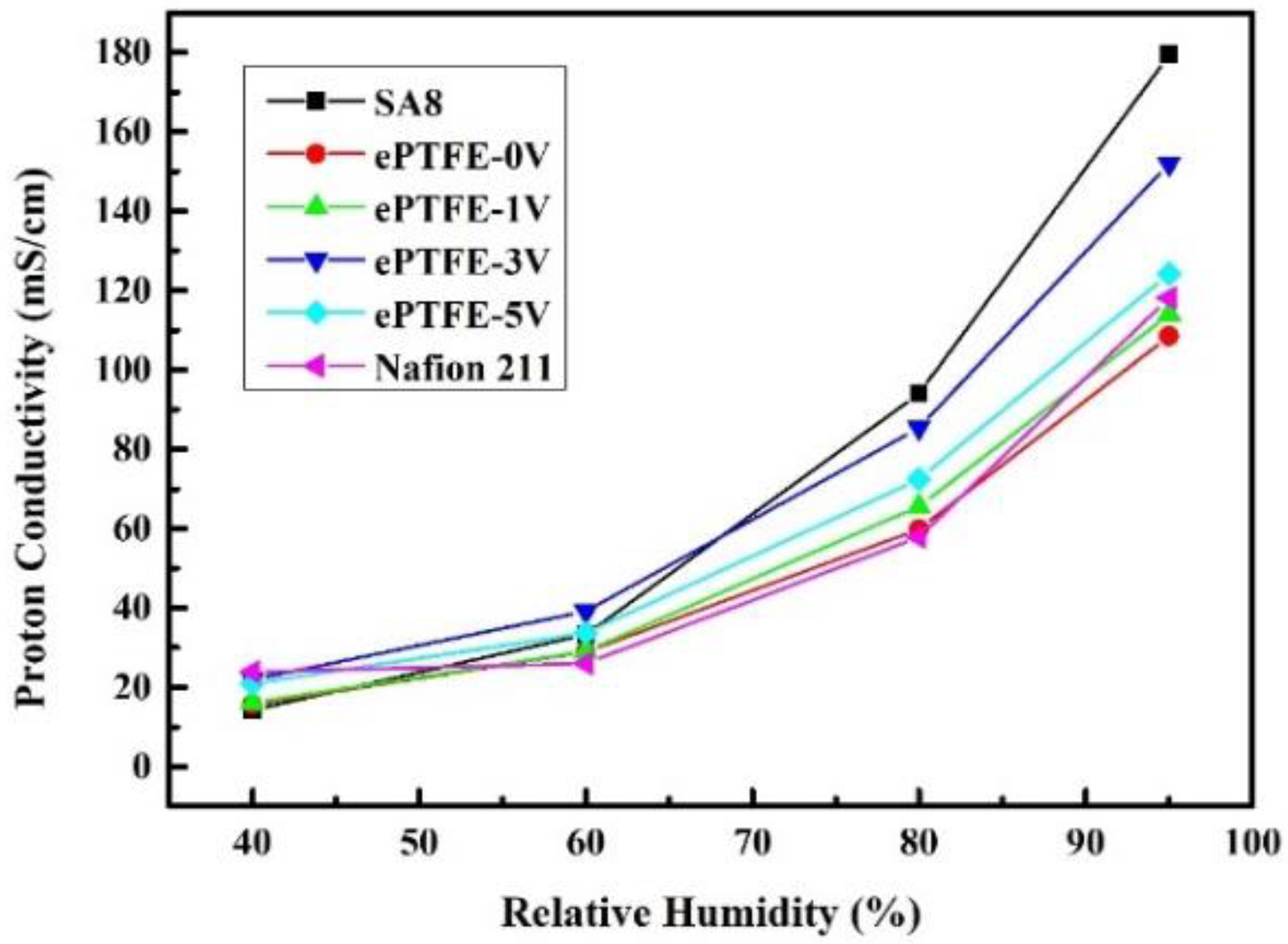
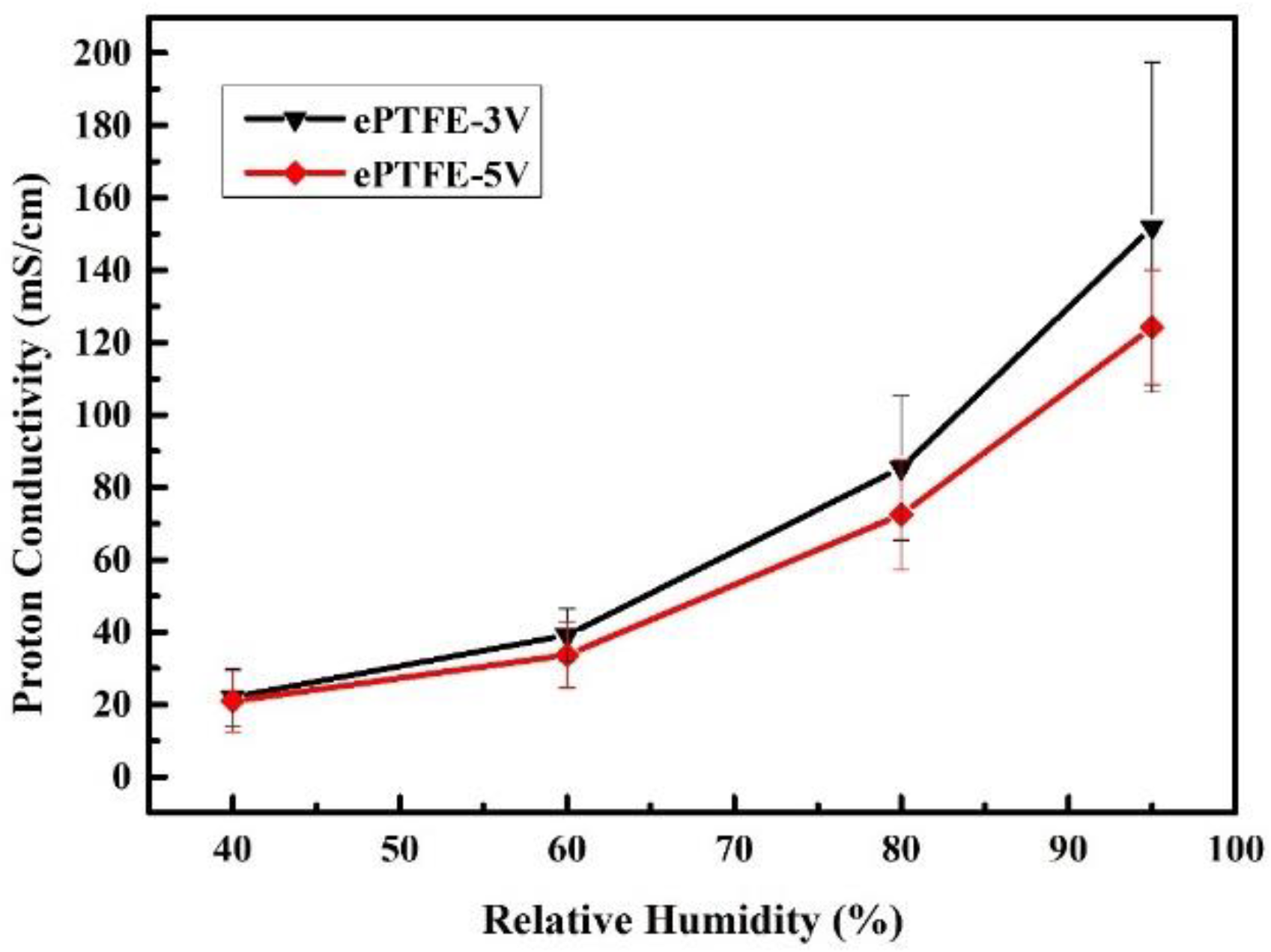
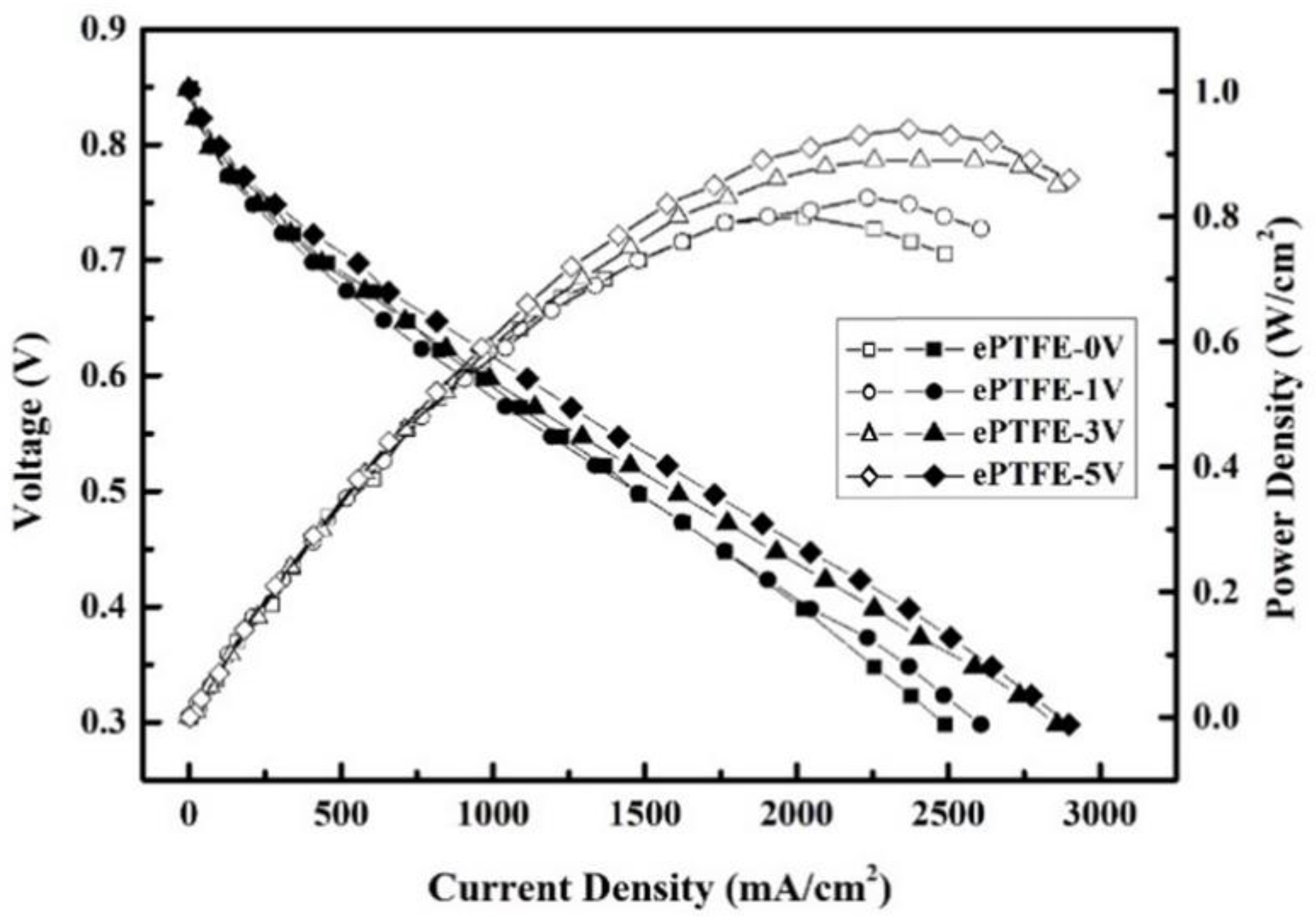

| Sample Name | IEC (Tirt.) (mmol/g) a | IEC (Theo.) (mmol/g) b | Degree of Sulfonation (%) c |
|---|---|---|---|
| SA8 | 3.01 | 3.71 | 81.20 |
| EPTFE-0 V | 1.95 | 1.34 | 145.24 |
| EPTFE-1 V | 1.98 | 1.89 | 104.98 |
| EPTFE-3 V | 2.1 | 2.13 | 98.66 |
| EPTFE-5 V | 2.18 | 2.32 | 93.84 |
| Sample | Hydration Number (Λ) | |||
|---|---|---|---|---|
| 25 °C | 50 °C | 70 °C | 90 °C | |
| SA8 | 11.91 | 16.30 | 17.51 | 20.20 |
| EPTFE-0 V | 11.19 | 10.36 | 11.49 | 13.16 |
| EPTFE-1 V | 10.95 | 12.32 | 12.80 | 18.99 |
| EPTFE-3 V | 11.13 | 12.70 | 14.75 | 20.29 |
| EPTFE-5 V | 11.62 | 12.85 | 17.42 | 23.89 |
| NAFION 211 | 8.55 | 10.99 | 15.68 | 18.00 |
Publisher’s Note: MDPI stays neutral with regard to jurisdictional claims in published maps and institutional affiliations. |
© 2022 by the authors. Licensee MDPI, Basel, Switzerland. This article is an open access article distributed under the terms and conditions of the Creative Commons Attribution (CC BY) license (https://creativecommons.org/licenses/by/4.0/).
Share and Cite
Hsieh, T.-L.; Guo, W.-H.; Chang, M.-Y.; Huang, W.-Y.; Wen, H.-Y. Electric Field-Assisted Filling of Sulfonated Polymers in ePTFE Backing Material for Fuel Cell. Membranes 2022, 12, 974. https://doi.org/10.3390/membranes12100974
Hsieh T-L, Guo W-H, Chang M-Y, Huang W-Y, Wen H-Y. Electric Field-Assisted Filling of Sulfonated Polymers in ePTFE Backing Material for Fuel Cell. Membranes. 2022; 12(10):974. https://doi.org/10.3390/membranes12100974
Chicago/Turabian StyleHsieh, Tung-Li, Wen-Hui Guo, Mei-Ying Chang, Wen-Yao Huang, and Hsin-Yi Wen. 2022. "Electric Field-Assisted Filling of Sulfonated Polymers in ePTFE Backing Material for Fuel Cell" Membranes 12, no. 10: 974. https://doi.org/10.3390/membranes12100974
APA StyleHsieh, T.-L., Guo, W.-H., Chang, M.-Y., Huang, W.-Y., & Wen, H.-Y. (2022). Electric Field-Assisted Filling of Sulfonated Polymers in ePTFE Backing Material for Fuel Cell. Membranes, 12(10), 974. https://doi.org/10.3390/membranes12100974









